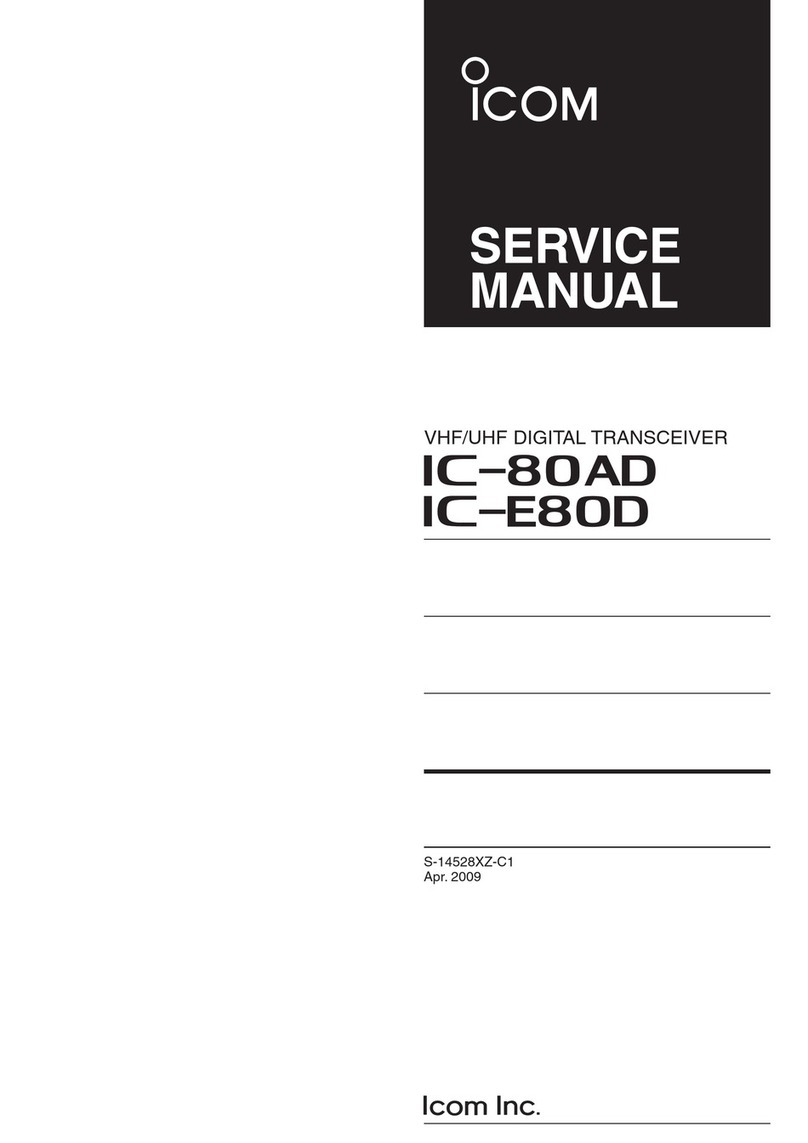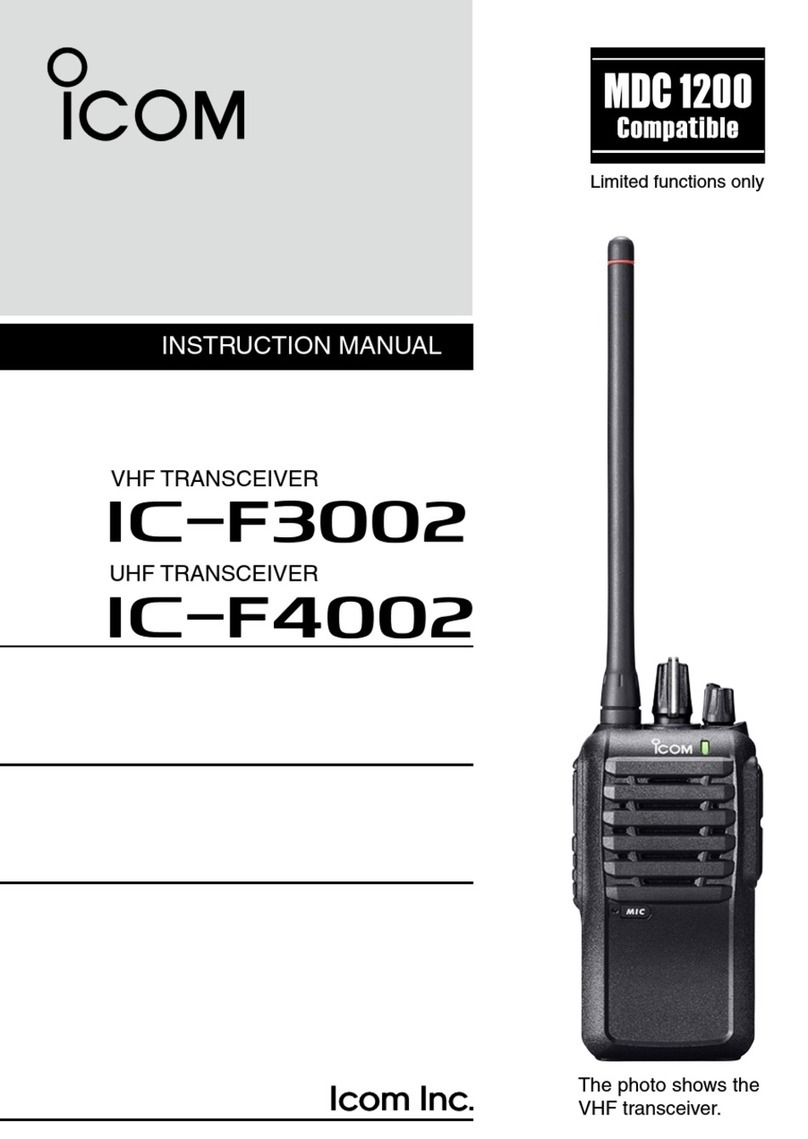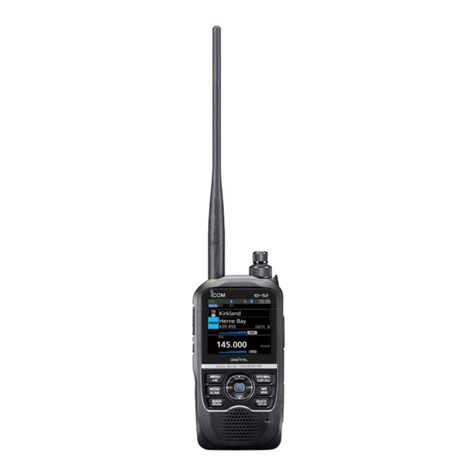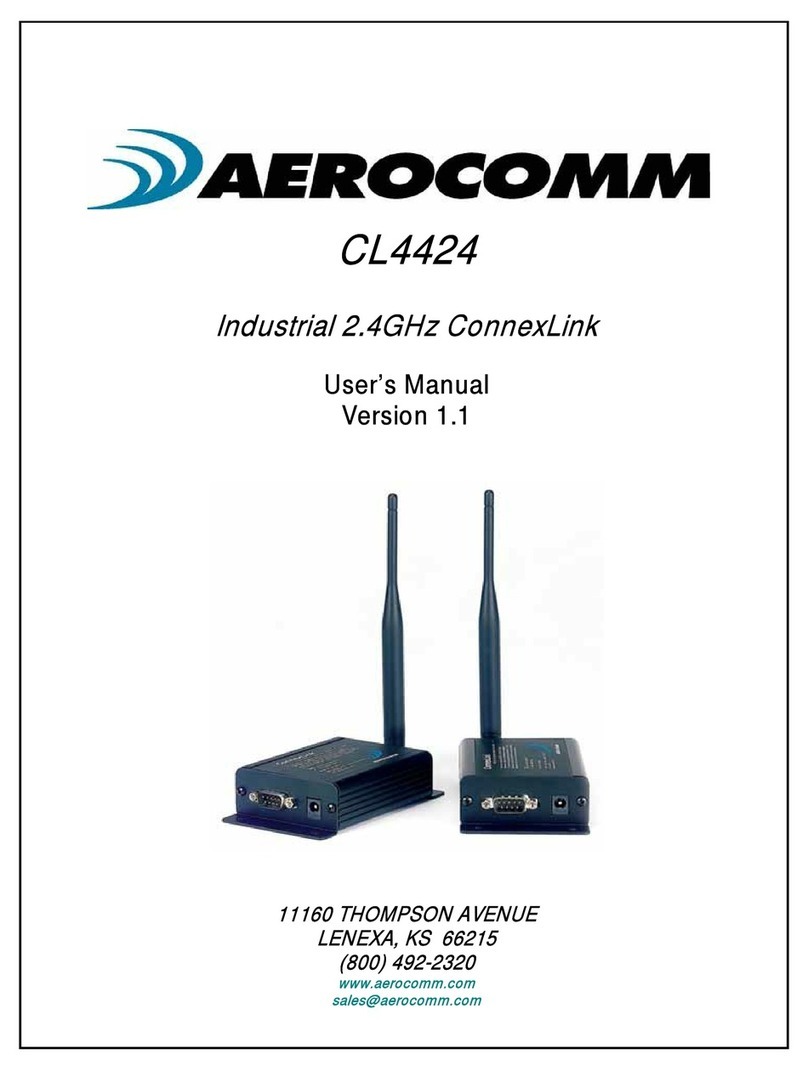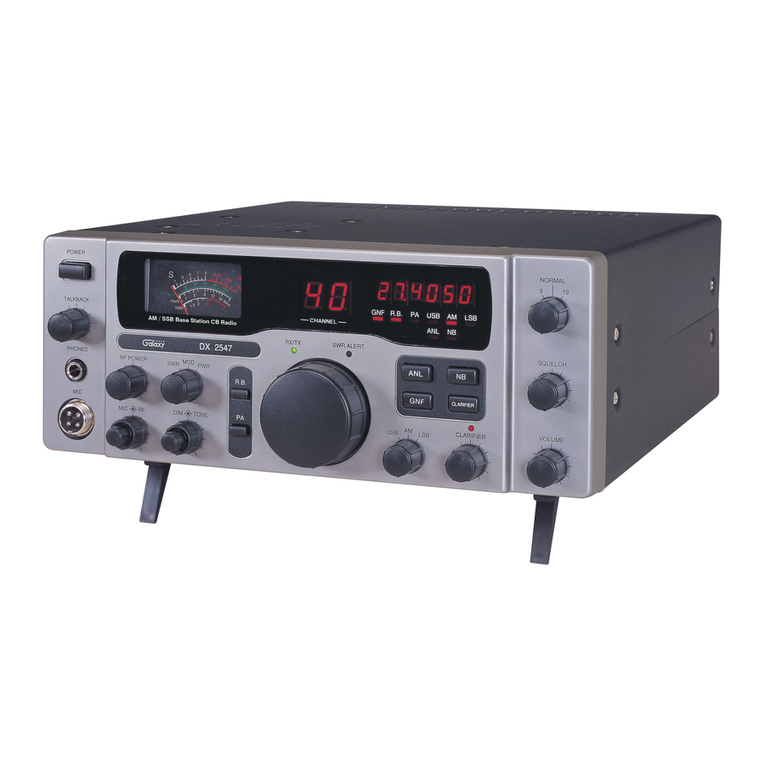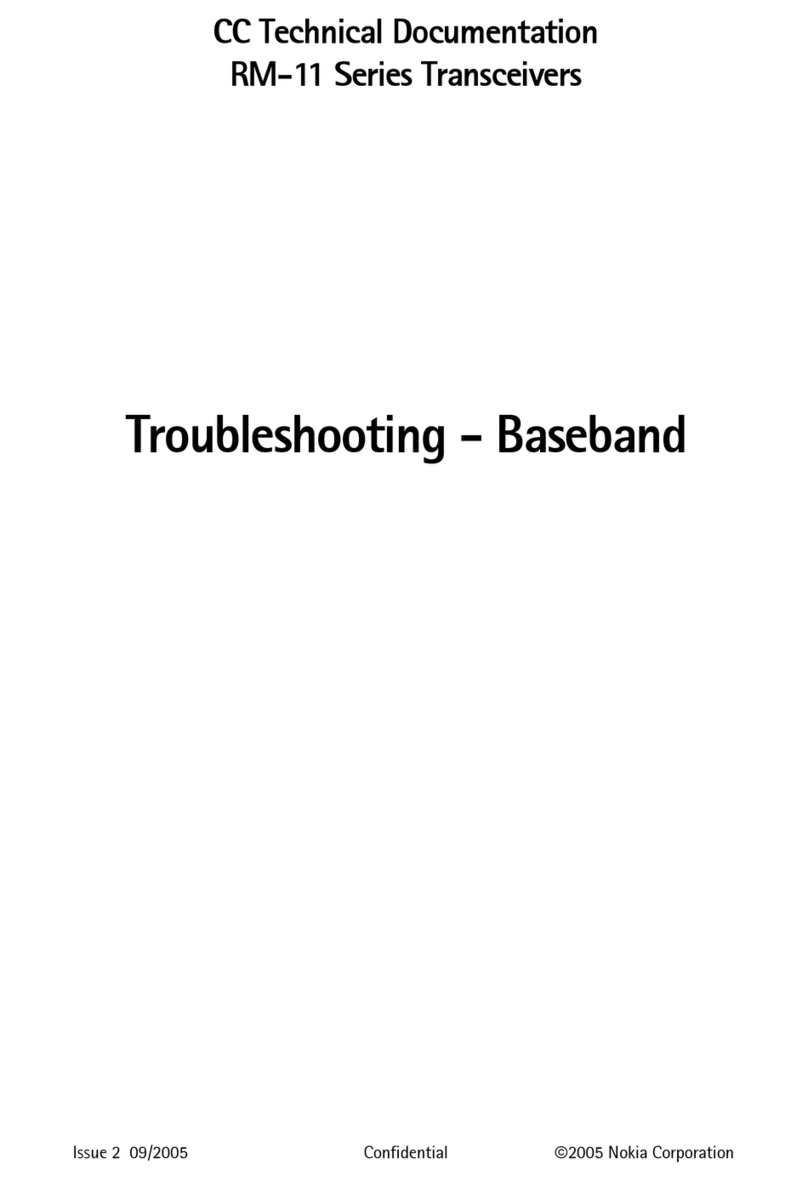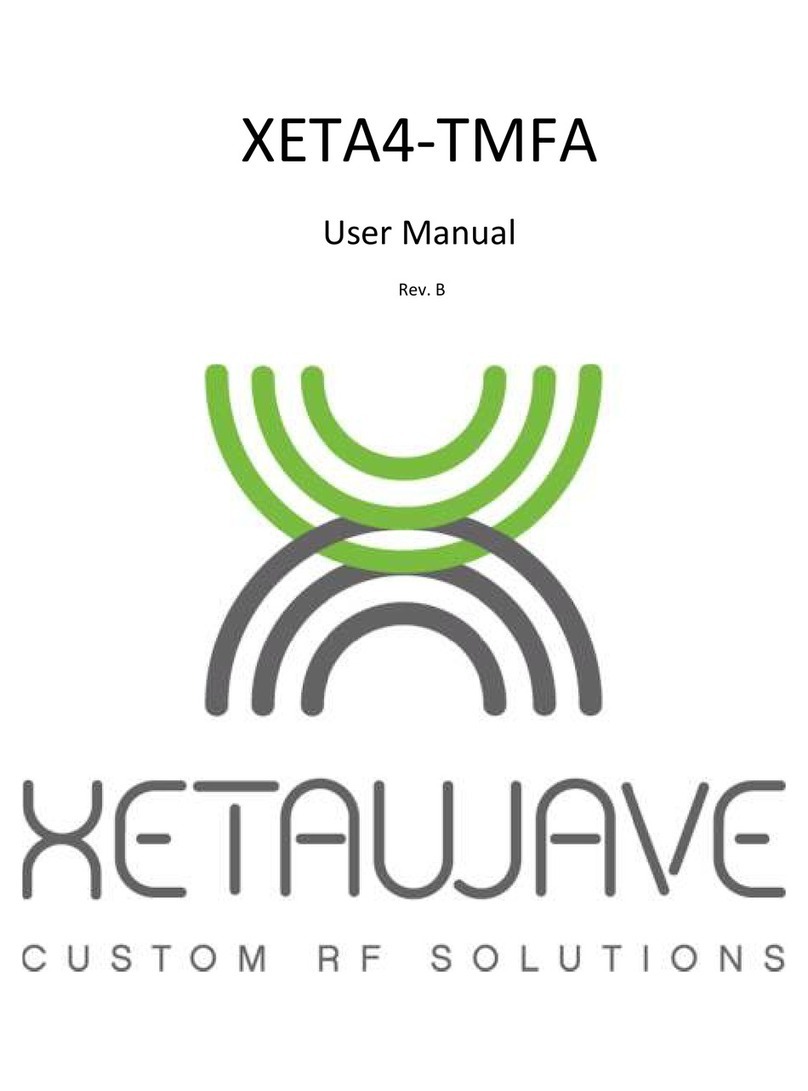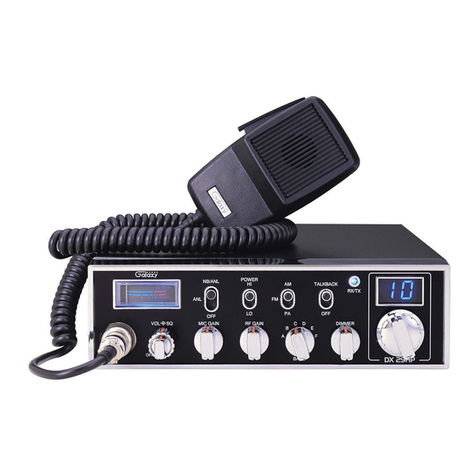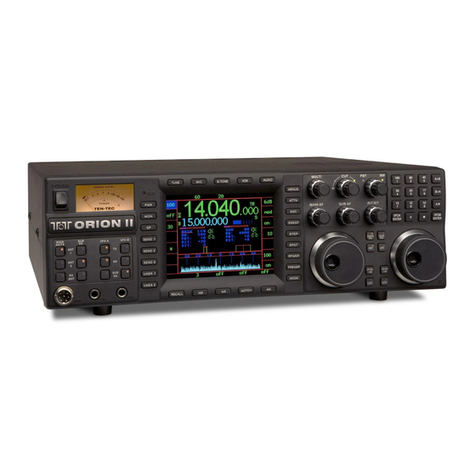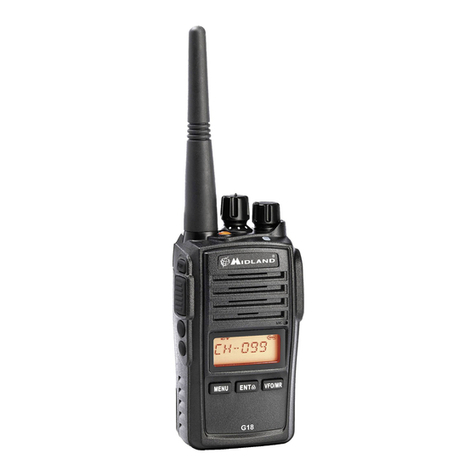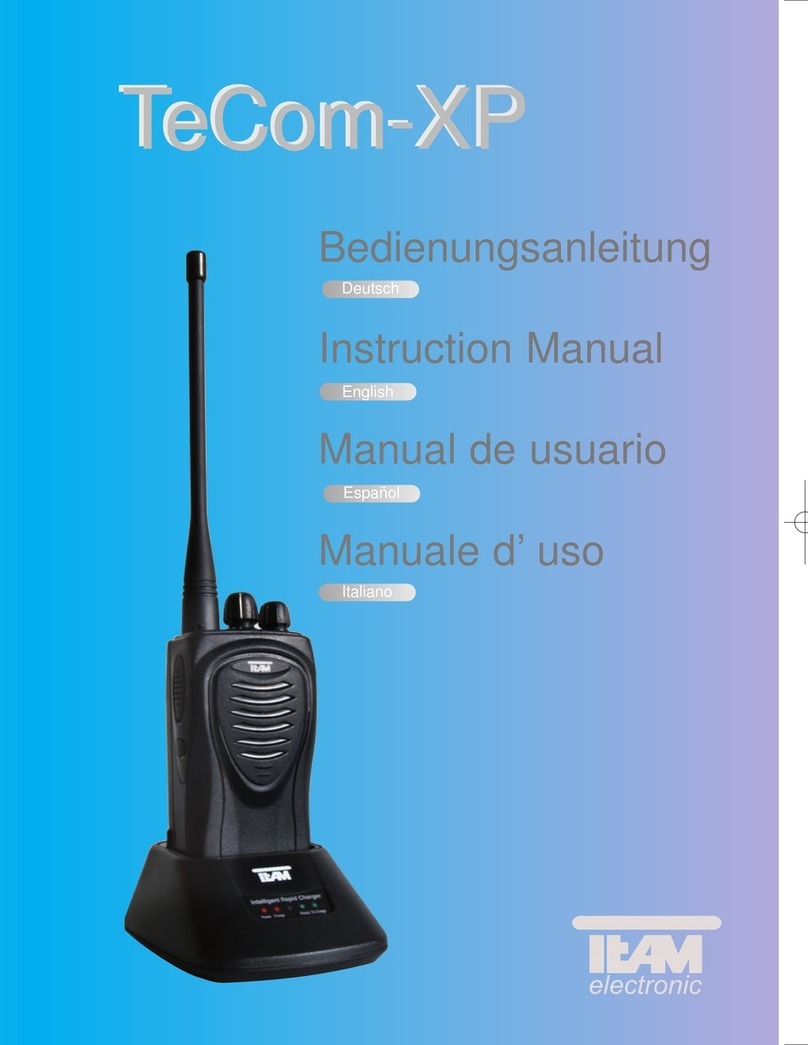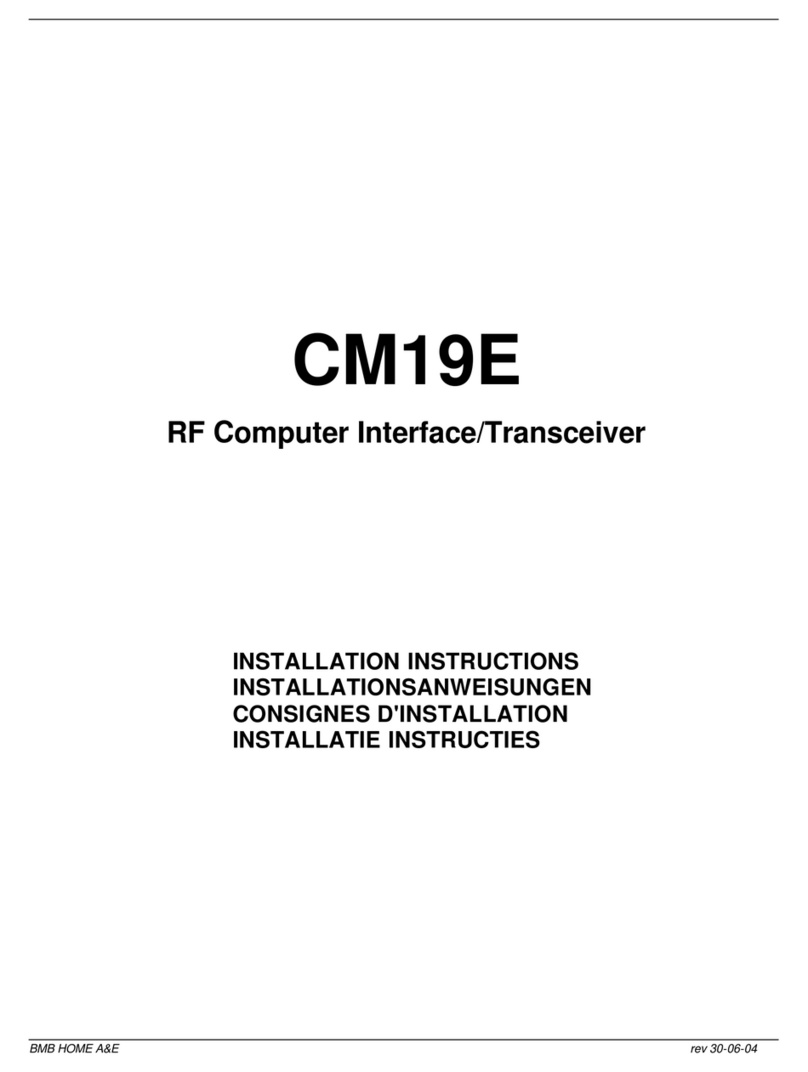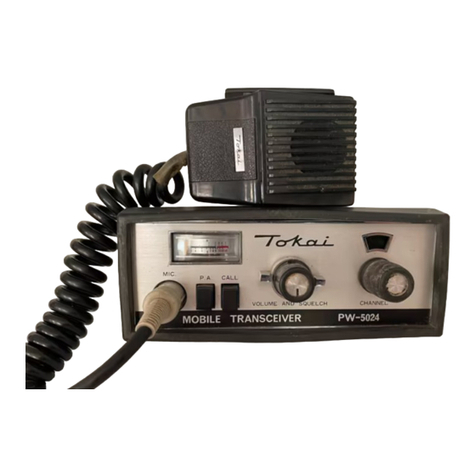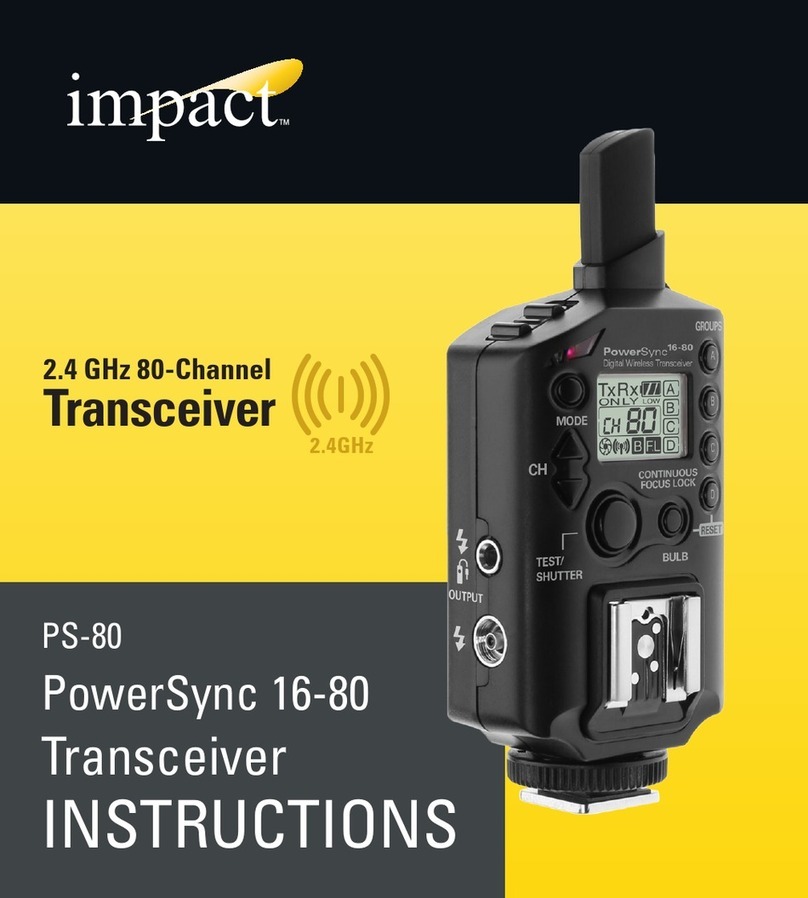Icom ID-51E User manual

S-14914XZ-C1
March 2013
VHF/UHF TRANSCEIVER

This service manual describes the latest technical informa-
tion for the ID-51A/ID-51E VHF/UHF TRANSCEIVER, at the time of
publication.
NEVER connect the transceiver to an AC outlet or to a DC
power supply that uses more than the specified voltage. This
will ruin the transceiver.
DO NOT reverse the polarities of the power supply when con-
necting the transceiver.
DO NOT apply an RF signal of more than 20 dBm (100 mW) to
the antenna connector. This could damage the transceiver’s
front-end.
To upgrade quality, any electrical or mechanical parts
and internal circuits are subject to change without notice
or obligation.
MODEL VERSION SUPPLIED
CHARGER
ID-51E
EUR BC-167SD
UK –
ITR BC-167SD
ID-51A
USA BC-167SA
KOR BC-167SD
EXP BC-167SA
EXP-01 BC-167SD
AUS BC-167SV
Be sure to include the following four points when ordering
replacement parts:
1. 10-digit Icom part number
2. Component name
3. Equipment model name and unit name
4. Quantity required
<ORDER EXAMPLE>
1110003491 S.IC TA31136FNG ID-51A MAIN UNIT 5 pieces
8820001210 Screw 2438 screw ID-51E Top cover 10 pieces
Addresses are provided on the inside back cover for your
convenience.
ORDERING PARTS
1. Make sure that the problem is internal before dis-assem-
bling the transceiver.
2. DO NOT open the transceiver until the transceiver is dis-
connected from its power source.
3. DO NOT force any of the variable components. Turn them
S-Lowly and smoothly.
4. DO NOT short any circuits or electronic parts. An insulated
tuning tool MUST be used for all adjustments.
5. DO NOT keep power ON for a long time when the trans-
ceiver is defective.
6. DO NOT transmit power into a Standard Signal Generator
or a Sweep Generator.
7. ALWAYS connect a 30 dB to 40 dB attenuator between the
transceiver and a Deviation Meter or Spectrum Analyzer,
when using such test equipment.
8. READ the instructions of the test equipment thoroughly
before connecting it to the transceiver.
REPAIR NOTES
INTRODUCTION
CAUTION
(ID-51A)
Icom, Icom Inc. and the Icom logo are registered trademarks of Icom Incorporated (Japan) in Japan, the United States, the
United Kingdom, Germany, France, Spain, Russia and/or other countries.

TABLE OF CONTENTS
SECTION 1 SPECIFICATIONS
SECTION 2 INSIDE VIEWS
SECTION 3 DISASSEMBLY INSTRUCTION
SECTION 4 CIRCUIT DESCRIPITON
4-1 RECEIVER CIRCUITS................................................................................................. 4-1
4-2 TRANSMITTER CIRCUITS.......................................................................................... 4-2
4-3 FREQUENCY SYNTHESIZER CIRCUITS .................................................................. 4-4
4-4 VOLTAGE BLOCK DIAGRAM ...................................................................................... 4-4
4-5 PORT ALLOCATIONS ................................................................................................. 4-5
SECTION 5 ADJUSTMENT PROCEDURES
5-1 PREPARATION ............................................................................................................ 5-1
5-2 FREQUENCY ADJUSTMENT ..................................................................................... 5-3
5-3 TRANSMIT ADJUSTMENT.......................................................................................... 5-3
5-4 RECEIVE ADJUSTMENT ............................................................................................ 5-11
SECTION 6 PARTS LIST
SECTION 7 MECHANICAL PARTS
SECTION 8 BOARD LAYOUTS
SECTION 9 BLOCK DIAGRAM
SECTION 10 VOLTAGE DIAGRAM

1 - 1
SECTION 1
.
SPECIFICATIONS
DGeneral
• Frequency coverage : (unit: MHz)
Version TX RX
EUR, KOR 144–146, 430–440 144–146, 430–440
UK 144–146, 430–440 108–174*1, 380–479*2
ITR 144–146, 430–434,
435–438
108–136.995,*1144–146,
430–434, 435–438
U.S.A. 144–148, 430–450*3108–174*4, 380–479*3
EXP 137–174*4, 400–479*2108–174*4, 380–479*2
EXP-1 144–148, 430–440 108–174*4, 380–479*2
ALL –BC Radio (AM): 0.520–1.710 MHz
BC Radio (FM): 76.0–108.0 MHz*5
*1Guaranteed 144–146 MHz only
*2Guaranteed 430–440 MHz only
*3Guaranteed 440–450 MHz only
*4Guaranteed 144–148 MHz only
*588.0–108.0 MHz for the USA version.
The SUB band audio signal may be muted, depending on
the combination of operating band and mode.
• Mode : FM, AM (Rx only), DV
• Number of memory channels
:
554
(incl. 50 scan edges and 4 call channels)
• Number of BC radio memory channels
:
500
• Usable temp. range : –20°C to +60°C; –4°F to +140°F
• Tuning steps :
1, 5, 6.25, 8.33, 9, 10, 12.5, 15, 20,
25, 30, 50, 100, 125 and 200 kHz
*The selectable steps may differ, depending on the selected fre-
quency band or operating mode.
• Frequency stability : ±2.5 ppm
(–20°C to +60°C; –4°F to +140°F)
• Power supply : 10.0–16.0 V DC for external DC
power, or specified Icom’s battery
pack
•
Digital transmission speed
: 4.8 kbps
• Voice coding speed : 2.4 kbps
• Current drain (at 7.4 V DC) :
TX (at 5 W) Less than 2.5A
RX Max. output FM Less than 350 mA (Internal speaker)
Less than 200 mA (External speaker)
DV Less than 450 mA (Internal speaker)
Less than 300 mA (External speaker)
• Antenna connector : SMA (50 Ω)
• Dimensions : 58(W)×105.4(H)×26.4(D) mm;
(projections not included) 2.3(W)×4.1(H)×1.0(D) in
• Weight (approximately) : 255 g; 9 oz
(incl. battery pack and antenna)
DTransmitter
• Modulation system :
FM Variable reactance frequency
modulation
DV GMSK reactance frequency
modulation
• Output power (at 7.4 V DC):
High 5.0 W, Mid. 2.5 W,
Low2 1.0 W, Low1 0.5 W,
S-Low 0.1 W (Typical)
•
Max. frequency deviation
: ±5.0 kHz (FM wide: approx.)
±2.5 kHz (FM narrow: approx.)
• Spurious emissions : Less than –60 dBc at High/Mid.
Less than –13 dBm at Low2/
Low1/S-Low
• Ext. mic. impedance : 2.2 kΩ
DReceiver
• Receive system : Double-conversion
superheterodyne
• Intermediate frequencies
A Band : 46.35 MHz (1st IF)
: 450 kHz (2nd IF)
B Band : 61.65 MHz (1st IF)
: 450 kHz (2nd IF)
• Sensitivity (except spurious points)
FM (1 kHz/3.5 kHz Deviation; 12 dB SINAD)
:
Less than –15 dBµ
DV
(PN9/GMSK 4.8 kbps; BER 1%)
:
Less than –11 dBµ
• Audio output power (at 10% distortion)
Internal speaker :
More than 0.4 W with a 16 Ωload
External speaker : More than 0.2 W with a 8 Ωload
• Selectivity
FM
(Wide) : More than 55 dB
FM
(Narrow), DV : More than 50 dB
•
Ext. speaker connector
: 3-conductor 3.5(d) mm; (1⁄8˝)/8 Ω
• Spurious and image rejection ratio
: More than 60 dB
• Squelch Sensitivity (threshold, 1 kHz/3.5 kHz Deviation)
: Less than –15 dBµ

2 - 1
SECTION 2
.
INSIDE VIEWS
DSP
• LOGIC UNIT
LEVEL CONVERTER
(IC21)
EEPROM
(IC7)
MIC SW
(Q21)
PTT SW
(Q20)
3VS LINE REGULATOR
(IC12)
AF AMP
(IC2)
DSP FLASH MEMORY
(IC20)
MIC MUTE SW
(IC16)
MODE SW
(IC390)
EEPROM
(IC3)
CPU
(IC5)
CLOCK OSCILLATOR
(For the CPU)
(X2)
microSD CARD SLOT
(J3)
GPS REGULATOR
(IC10)
VCC LINE REGULATOR
(IC4)
AF AMP
(IC300)
TONE FILTER
(Q330)
AF FILTER
(IC350)
CPU3 LINE REGULATOR
(IC9)
TONE FILTER
(Q370)
CHARGING CONTROLLER
(IC8)

2 - 2
• MAIN UNIT
(TOP VIEW)
VCC LINE SW
(Q8)
POWER AMP
(Q45)
3VS LINE REGULATOR
(IC12)
PLL IC (Band A)
(IC6)
DISCRIMINATOR
(Band A)
(X2)
2ND IF FILTER (Band A)
(For DV and FM-N modes)
(FI1)
AGC DETCTOR
(Q903)
2ND IF FILTER (Band A)
(For FM mode)
(FI2)
DISCRIMINATOR
(Band B)
(X900)
PLL IC (Band B)
(IC450)
D/A CONVERTER
(IC952)
ATT
(Q906)
REFERENCE FREQUENCY
OSCILLATOR
(X1)
AM DETECTOR
(Q904)
APC AMP
(IC14)
+5 V REGULATOR
(IC15)
VCC LINE SW
(Q2)
ATT
(Q907)
CURRENT DETECTOR
(IC5)
LOCK VOLTAGE BUFFER
(Q451)
2ND IF FILTER (Band B)
(For FM and AM modes)
(FI900)
+4 V REGULATOR
(IC3)
RF AMP
(Q780)

2 - 3
• MAIN UNIT
(BOTTOM VIEW)
UHF RF AMP (Band A/B)
(Q602)
VHF RF AMP (Band A/B)
(Q702)
5VS LINE REGULATOR
(IC4)
IF IC (Band B)
(IC901)
1ST IF AMP (Band B)
(Q901)
1ST IF FILTER (Band B)
(FI880)
UHF RF AMP (Band B)
(Q641)
VHF RF AMP (Band B)
(Q740)
UHF RF AMP (Band A)
(Q601)
VHF RF AMP (Band A)
(Q701)
AF AMP
(IC2)
PS3 LINE REGULATOR
(IC13)
CHARGING CONTROLLER
(IC8)
1ST IF FILTER (Band A)
(FI3)
DRIVE AMP
(Q41)
RADIO IC
(IC441)
IF IC (Band A)
(IC13)
RADIO AUDIO BUFFER
(IC955)
+3.3 V REGULATOR
(IC11)

3 - 1
SECTION 3
.
DISASSEMBLY INSTRUCTION
BE CAREFUL about the flat cable and connector when
separating the LOGIC UNIT from the chassis.
1. REMOVING THE LOGIC UNIT
1) Remove 2 dials and antenna nut from the front panel.
2) Remove 2 screws from the bottom of chassis.
3) Take out the LOGIC UNIT with chassis from the
front panel.
4) Remove 6 screws from the LOGIC UNIT.
5) Unsolder 6 points at the rotary encoder.
6) Separate the LOGIC UNIT from the chassis, and
then disconnect the flat cable from the LOGIC UNIT.
,
)25
Inner dial
Outer dial
Antenna nut
Remove with;
“ICOM Driver (Q)”
(8960000370)
,
)25
Screws
,
)25
LOGIC UNIT
with chassis
Front panel
,
)25
UNSOLDER
Solder
remover
Screws x5
LOGIC UNIT
Rotary encoder
,
,
)25
)25
FLAT CABLE
Lift up
flat cable
LOGIC UNIT
Chassis
Suction lifter
Suction lifter
• Part name : EA950R-2
• Manufacture : ESCO CO.LTD
For easy separation of the CHASSIS
Use a suction lifter to lift the bottom of the CHASSIS up.
(Continued on page 3-2)

3 - 2
2. REMOVING THE MAIN UNIT
1) Unsolder 2 points on the shield plate.
,
)25
Shield plate
UNSOLDER
Solder
remover
,
)25
Screws x5
MAIN UNIT
Shield plate
,
)25
UNSOLDER
Solder
remover
,
)25
Screws x6
Chassis
A
IN UNIT
2) Remove 5 screws from the shield plate, and then
remove it.
3) Unsolder a point at the antenna connector.
4) Remove 6 screws from the MAIN UNIT, and then
remove the MAIN UNIT from the chassis.

4 - 1
• RF CIRCUITS
SECTION 4
.
CIRCUIT DESCRIPTION
4-1 RECEIVE CIRCUITS
RF CIRCUITS
VHF BAND (108–174 MHz)
The RF signal from the antenna is passed through two LPFs
(L513, L515, L516, C547, C549, C553, C555 and C556),
ANT SW (D506, D903) and BPF (L705, L706, L909, C724
and C976), and then applied to the RF AMP (Q702).
• Band A (137–174 MHz)
The amplified signal is passed through the BPF (D705, L703
and C715) and AGC circuit (Q49, Q50, D34, D704), and then
applied to the RF AMP (Q701).
The amplified signal is applied to the 1st IF circuit, through
the BPF (D702, D703, L701, C703 to C705).
• Band B (108–174 MHz)
The amplified signal is passed through the ATT (D745), BPF
(D744, L742 and C753) and AGC circuit (Q903, D743), and
then applied to the RF AMP (Q740).
The amplified signal is applied to the 1st IF circuit, through
the BPF (D741, D742, L740, C741 to C743).
D506,D903
RX:380.000M~479.000MHz
D501
D508
D510
RX:108.000M~174.000MHz
TX:400.000M~479.000MHz
TX:136.000M~174.000MHz
D503,D504
From the TX circuit
From the TX circuit
Q702
D705D702,D703
Q740
-Band A:137M-174MHz-
-Band B:108M-174MHz-
D744
Q701
D741,D742
-Band A:380M~479MHz-
Q601
Q602
D605,D606
-Band B:380M~479MHz-
Q641
108M-174MHz
380M-479MHz
D602,D603
D642,D643 D645,D646
AGC
AGC
AGC
AGC
Q49,Q50,D34
Q903,D743
Q49,Q50,D34
Q903,D644
D704
D604
D745
To the 1st IF circuit (Band A).
To the 1st IF circuit (Band B).
To the 1st IF circuit (Band B).
To the 1st IF circuit (Band A). ANT
SW HPF
LPF
LPF LPF
ANT
SW LPF
BPF
BPF RF
AMP
BPF
BPF RF
AMP
RF
AMP
RF
AMP
RF
AMP
BPF
RF
AMP BPFBPF
BPF
ATT
UHF BAND (380–479 MHz)
The RF signal from the antenna is passed through the HPF
(L512, L514, C545, C548, C550, C551 and C554), two LPFs
(L511, C536, C539 and L507, C524, C526, C529), ANT SW
(D508 and D510) and BPF (L608, L610, L612, C630, C631
and C634), and then applied to the RF AMP (Q602).
• Band A
The amplified signal is passed through the two BPFs (D605,
L605, C615 and D606, L606, C619) and AGC circuit (Q49,
Q50, D34, D604), and then applied to the RF AMP (Q601).
The amplified signal is applied to the 1st IF circuit, through the
BPF (D602, D603, L602, L603, C603 to C605, C607, C907).
• Band B
The amplified signal is passed through the BPF (D645, D646,
L644, L645, C654, C655, C658) and AGC circuit (Q903,
D644), and then applied to the RF AMP (Q641).
The amplified signal is applied to the 1st IF circuit, through
the BPF (D642, D643. L641, L642, C642 to C644, C646 and
C972).

• 1ST IF CIRCUITS
4 - 2
1ST IF CIRCUITS
VHF BAND (108–174 MHz)
• Band A (137–174 MHz)
The RX signal from the RF circuit is applied to the 1st mixer
(Q820) and mixed with the 1st LO signal, resulting in the 46.35
MHz 1st IF signal.The converted signal is passed through the
RF SW (D820), 1st IF filter (FI3) and limiter (D23), and then
applied to the 1st IF AMP. (Q44). The amplified signal is ap-
plied to the 2nd IF circuit, through the limiter (D22).
• Band B (108–174 MHz)
The RX signal from the RF circuit is applied to the 1st mixer
(Q830) and mixed with the 1st LO signal, resulting in the 61.65
MHz 1st IF signal.The converted signal is passed through the
RF SW (D830), 1st IF filter (FI880) and limiter (D880), and
then applied to the 1st IF AMP. (Q901).The amplified signal is
applied to the 2nd IF circuit.
-Band A:46.35MHz-
-Band B:61.65MHz-
D22 FI3
A_LO
1st LO
1st LO
LIMIT
46.35MHz
Q44
LIMIT
D23
Q901
B_LO
61.65MHz
D880 FI880
Q811
VCO1 UNIT
Q830
D812,D831
Q801
Q820
D811,D830
LIMIT
VCO2 UNIT
D801,D820
D802,D821
To the 2nd IF circuit (Band A).
To the 2nd IF circuit (Band B).
From the RF circuit (Band A).
From the RF circuit (Band A).
From the RF circuit (Band B).
From the RF circuit (Band B).
BPF
XTALIF
AMP
IF
AMP BPF
XTAL RF
SW
RF
SW
RF
SW
RF
SW
UHF BAND (380–479 MHz)
• Band A
The RX signal from the RF circuit is applied to the 1st mixer
(Q801) and mixed with the 1st LO signal, resulting in the 46.35
MHz 1st IF signal.The converted signal is passed through the
RF SW (D801), 1st IF filter (FI3) and limiter (D23), and then
applied to the 1st IF AMP. (Q44). The amplified signal is ap-
plied to the 2nd IF circuit, through the limiter (D22).
• Band B
The RX signal from the RF circuit is applied to the 1st mixer
(Q811) and mixed with the 1st LO signal, resulting in the 61.65
MHz 1st IF signal.The converted signal is passed through the
RF SW (D811), 1st IF filter (FI880) and limiter (D880), and
then applied to the 1st IF AMP. (Q901).The amplified signal is
applied to the 2nd IF circuit.

4 - 3
2ND IF CIRCUITS
• Band A
The 1st IF signal from the 1st IF circuit is applied to the IF IC
(IC13, pin 16), which contains the 2nd IF AMP, 2nd mixer, FM
demodulator, and so on.
The 1st IF signal is mixed with the 45.9 MHz 2nd LO signal,
resulting in the 450 kHz 2nd IF signal. The converted sig-
nal is passed through the external 2nd IF filter (FM mode;
FI2, FM-N or DV mode; FI1) to remove sideband noise. The
filtered signal is amplified by the 2nd IF AMP, and then de-
modulated by the quadrature detector (X2).
The demodulated signal is applied to the RX AF circuit (For
FM and FM-N modes) or digital demodulation circuit (For DV
mode).
Q38
X1
15.3MHz
X3
REF
45.9MHz
-Band A:46.35MHz-
-Band B:61.65MHz-
SW
FM
DISCRI
FM-N/DV
D16,D18,D19
IC13
FI2
W/N
FI1
X2
Q36,D15
FI900
DISCRI
X900
FM
IC901
Q900
61.2MHz
REF X4
IC18
MODE
SW
Q904
From the 1st IF circuit (Band A).
To the RX AF circuit (Band A).
To the RX AF circuit (Band B).
From the 1st IF circuit (Band A).
BPF
BPF
CERAMIC
BPF
CERAMIC
BPF
CERAMIC
BPF
AM
DET
DET
FM
DET
FM
• Band B
The 1st IF signal from the 1st IF circuit is applied to the IF IC
(IC901, pin 16), which contains the 2nd IF AMP, 2nd mixer,
FM demodulator, and so on.
The 1st IF signal is mixed with the 61.2 MHz 2nd LO signal,
resulting in the 450 kHz 2nd IF signal. The converted signal
is passed through the external 2nd IF filter (FI900) to remove
sideband noise.
While receiving in the FM mode, the filtered signal is amplified
by the 2nd IF AMP, and then demodulated by the quadrature
detector (X900). The demodulated signal is applied to the RX
AF circuit, through the AF SW (IC18, pins 6, 1).
While receiving in the AM mode, the filtered signal is demod-
ulated by Q904 and amplified by the AGC AMP (Q903). The
demodulated signal is applied to the RX AF circuit, through
the AF SW (IC18, pins 7, 1).
• 2ND IF CIRCUITS

4 - 4
• RADIO RECEIVE CIRCUITS
IC2
VO-
VO+
IC11
IC25
MAIN UNIT
LOGIC UNIT
CHASSIS UNIT
[SP] jack
-Band A:FM/FM-N mode-
-Band A:DV mode-
-Band A:FM/AM mode-
Radio AF
AF
IC350,Q350
FIL
SW
MUTE
BAF
CODEC
LINEAR
IC18
DSP
IC19
ADET
BDET
Q20
IC351
IC20
FIL SW
MODE
AF
IC300,Q301
IC390
AAF
From the
2nd IF circuit
(Band A).
From the
2nd IF circuit
(Band B).
IC300
IC300 Q302,Q300
AF
AMP
J4
SP1
Int. speaker
A/D LPF
BUFF
ATT
AMP
LPFAMP
DAFO
D/A
• DIGITAL DEMODULATION AND RX AF CIRCUITS
DIGITAL DEMODULATION CIRCUIT (LOGIC UNIT)
While operating in the DV mode, the demodulated signal
(digital audio signal) is passed through the LPF (R305, R336,
R339, C334 and C337) and amplified by the AF AMP (IC300,
pins 2 and 1). The amplified signal is passed through the LPF
(Q300 and Q302) and amplified by another AF AMP (IC300,
pins 13 and 14), and then applied to the A/D converter (IC19,
pin 3) to be converted into the digital audio signal.
The digital audio signal is demodulated by the DSP (IC18,
pins M10 and L11), and then applied to the linear codec
(IC25) to be decoded into an analog audio signal.
The decoded AF signal is applied to the RX AF circuit.
RX AF CIRCUIT (LOGIC AND MAIN UNITS)
• Band A
The demodulated AF signal is passed through the mode SW
(IC390, pins 4 and 3) and AF filter (IC300, pins 9 and 8, 5
and 7), and then applied to the D/A converter (MAIN UNIT:
IC11, pin 18) to be adjusted in volume level.
• Band B
The demodulated AF signal is passed through the AF filter
(IC350, pins 2 and 1, 5 and 7) and mute SW (IC351, pins 2
and 1), and then applied to the D/A converter (MAIN UNIT:
IC11, pin 1) to be adjusted in volume level.
The level-adjusted AF signal is amplified by the buffer (MAIN
UNIT: IC20, pins 3 and 4), and then applied to the AF power
AMP (MAIN UNIT: IC2, pin 1), through the ATT (MAIN UNIT:
Q20).
The amplified AF signal is output to the internal speaker
(CHASSIS: SP1) or external speaker, through the [SP] jack
(MAIN UNIT: J4).
RADIO RECEIVE CIRCUITS
• FM BAND (76–108 MHz)
The RF signal from the antenna or earphone is passed through
two LPFs (L513, L515, L516, C547, C549, C553, C555 and
C556), ANT SW (D506 and D903), RF SW (D781), ANT SW
(D782 and D783) and LPF (L781, L782, C783 to C786), and
then applied to the RF AMP (Q780).
The amplified signal is applied to the radio IC (IC441, pin 2),
through the ATT (D908) and limiter (D904).
• AM BAND (0.52–1.71 MHz)
The RF signal from the antenna is passed through two LPFs
(L513, L515, L516, C547, C549, C553, C555 and C556),
ANT SW (D506 and D903), and LPF (L402, L403, C407–
C411), and then applied to the RF AMP (Q908).
The amplified signal is applied to the radio IC (IC441, pin 4),
through the ATT (Q906 and Q907) and limiter (D905).
The radio IC (IC441) demodulates input signals and output to
the RX AF circuit.
D782,
D783
- 76M-108MHz -
Q780
Q908
- 0.52M-1.71MHz -
LIMIT
D905
D904
LIMIT
RADIO
IC
IC441
Q906
Q907
D908 D781
IC955
<- RX AF
circuit
From the TX circuit
LPF
ANT
SW LPF
LPF
RF
AMP
LPF
RF
AMP
ATT
ATT RF
SW
ANT
SW
BUFF

4 - 5
4-2 TRANSMIT CIRCUITS
TX AF CIRCUIT (LOGIC UNIT)
The AF signal from the internal or external microphone (MIC
signal) is applied to the audio processor LSI (IC25), through
the ATT (R190 and R198).
The audio processor LSI contains 16-bit liner CODEC, MIC
AMP, audio filters, D/A converter, and so on.
• When operating in the DV mode
The applied signal is amplified by the MIC AMP, and passed
through the external MIC mute SW (IC16, pins 7, 1), and then
further amplified by the ALC AMP. The amplified signal is ap-
plied to the liner CODEC, through the LPF (R186, C174 and
C177), to be encoded into a digital audio signal.
The digital audio signal is processed by the DSP (IC18), and
then passed through the LPF (R125 and C124), mode SW
(IC390, Q390) and LPF (IC25) ,and then applied to the D/A
converter (IC25) to be adjusted in level.
The level-adjusted signal is applied to the modulation cir-
cuits.
• When operating in the FM/FM-N mode
The amplified signal is passed through the MIC mute SW
(IC16, pins 7, 1), HPF (R130, C160 and C161), BPF (IC25),
LPF (IC25) and mode SW (IC390, pins 8, 9), and then applied
to the D/A converter (IC25) to be adjusted in level, through
the mode SW (IC390, pins 11, 10) and LPF (IC25).
The level-adjusted signal is applied to the modulation cir-
cuits.
MODULATION CIRCUITS (MAIN UNIT)
The MIC signal from the TX AF circuits is applied to the VHF
VCO (Q311, D304–D306) or UHF VCO (Q27, D10–D12) as
a modulation signal.
The modulation signal is applied to D10 to obtain GMSK (For
DV mode) or Frequency Modulation (For FM mode).
The modulated VCO output signal is amplified by the buffer
(Q200) and LO AMP (Q201), and then applied to the TX AMP
circuits as the TX signal, through the LO SW (D14).
DMO
MMUTE
SW
DV
IC16
LOGIC UNIT
DMOD
EXTMIC
MAIN UNIT
FM
IC390
SW
MODE
LINEAR
CODEC
IC18
DSP
VCOMOD
IC25
HPF
J5
MIC
AMP
MC1
BPF LPF
LPF
ALC
AMP
ATT LPF LPF D/A
Q311,
D304,D305,D306 Q201
Q200
MAIN UNIT
VCO A UNIT
Q27,
D10,D11,D12
VHF
UHF
VCO BUFF LO
AMP
VCO
TX AMP circuit ->
TX AF circuit ->
• TX AF CIRCUIT
• MODULATION CIRCUIT

4 - 6
MAIN UNIT
D506,D903
RX:380.000M~479.000MHz
D501
D508
D510
IC14B
MUTE
LO
D20,D21
RX:108.000M~174.000MHz
TX:400.000M~479.000MHz
TXMUTE
SW
Q41
D505,D509
Q43
SW
Q39
TX:136.000M~174.000MHz
Q45
D14
D503,D504
PSET
1st mixer (Band A) ->
Receive circuit (UHF band) ->
Receive circuit (VHF band) ->
D512,D513
Q48
PWR
AMP
ANT
SW HPF
LPF
YGR
AMP LPFHPF LPF
PWR
DET
ANTENNA
APC
CTRL
ANT
SW
ATT
PWR
DET
LPF LPF
DRIVE
AMP
BUFF
TX AMP CIRCUITS (MAIN UNIT)
The TX signal is passed through the buffer (Q48) and ATT
(D20, D21), which controls the TX output power by the APC
AMP (IC14). The TX signal is sequentially amplified by the
YGR (Q39), drive AMP (Q41) and power AMP (Q45).
• While operating on the VHF band
The amplified TX signal is passed through the LPF (L501,
C511), ANT SW (D503 and D504), TX output power detector
(D512, D513) and two LPFs (L513, L515, L516, C547, C549,
C553, C555 and C556), before being applied to the antenna.
• While operating on the UHF band
The amplified TX signal is passed through the HPF (L502,
L503, C507, C508, C510 and C512), ANT SW (D501), TX
output power detectors (D505 and D509) and two LPFs
(L507, C524, C526, C529, and L511, C536, C539) and HPF
(L512, L514, C545, C548, C550, C551 and C554), before be-
ing applied to the antenna.
APC CIRCUITS (MAIN UNIT)
The voltage produced at the LPFs (VHF band; L513, L515,
L516, C547, C549, C553,C555 and C556, UHF band; L507,
C524, C526 and C529) is rectified by the diodes (VHF band;
D512 and D513, UHF band; D505 and D509), and it is used
as the TX power sensing voltage.
The voltage is applied to the APC AMP (IC14B, pin 6), and
the output voltage controls the bias voltages of the ATT (D20
and D21) to keep the TX output power constant.
• TX AMP AND APC CIRCUITS

4 - 7
4-3 FREQUENCY SYNTHESIZER CIRCUIT
(MAIN UNIT)
VCOs
The ID-51A/E has total of four VCOs; two VCOs for band A
and another two for band B.
• Band A
VHF VCO (VCO1 UNIT)
The VHF VCO (Q311, D304–D306) generates both 1st LO
signal (for receiving a VHF signal on band A) and the VHF
TX signal. The output of buffer (Q200) is amplified by the LO
AMP (Q201), and then used as the VHF TX/RX LO signal.
While receiving, the LO signal is applied to the 1st IF mixer
(Q820) for receiving a signal on the VHF band, through the
RF SW (D821).
While transmitting, the LO signal is applied to the TX AMP
circuits, through the LO SW (D14).
UHF VCO (VCO1 UNIT)
The UHF VCO (Q27, D10–D12) generates both 1st LO signal
(for receiving a UHF signal on band A) and the UHF TX sig-
nal. The output of buffer (Q200) is amplified by the LO AMP
(Q201), and then used as the UHF TX/RX LO signal.
While receiving, the LO signal is applied to the 1st IF mixer
(Q801) for receiving a signal on the UHF band, through the
RF SW (D802).
While transmitting, the LO signal is applied to the TX AMP
circuits, through the LO SW (D14).
• Band B
VHF VCO (VCO2 UNIT)
The VHF VCO (Q311, D304–D306) generates the 1st LO
signal (for receiving a VHF signal on band B). The output of
buffer (Q200) is amplified by the LO AMP (Q201), and then
used as the 1st LO signal.
While receiving, the LO signal is applied to the 1st IF mixer
(MAIN UNIT: Q830) for receiving a signal on the VHF band,
through the RF SW (MAIN UNIT: D831).
UHF VCO (VCO1 UNIT)
The UHF VCO (Q27, D10–D12) generates 1st LO signal
(for receiving a UHF signal on band B). The output of buffer
(Q200) is amplified by the LO AMP (Q201), and then used as
the UHF TX/RX LO signal.
While receiving, the LO signal is applied to the 1st IF mixer
(MAIN UNIT: Q811) for receiving a signal on the UHF band,
through the RF SW (MAIN UNIT: D812).
PLL
•Band A
A portion of VHF and UHF VCOs output signal is amplified
by two buffers (VCO1 UNIT: Q200 and Q202) and passed
through the LPF (VCO1 UNIT: L202, C209 to C211), and
then fed back to the PLL IC (IC6, pin 8).
The PLL IC (IC6) phase-compares the output of reference
frequency oscillator (TCXO; X1) and VCO, and the phase dif-
ference is output as the charge pump current. The current is
passed though the loop filter (R67, R71, R90, R93, C91, C92,
C96 and C102) to be converted into the lock voltage, which
controls the oscillating frequency of VCO.
When the oscillation frequency drifts, its phase changes from
that of the reference frequency, causing a lock voltage change
to compensate for the drift in the VCO oscillating frequency.
Band B
A portion of VHF and UHF VCOs output signal is amplified
by two buffers (VCO2 UNIT: Q200 and Q202) and passed
through the LPF (VCO2 UNIT: L202, C209 to C211), and
then fed back to the PLL IC (IC6, pin 8).
The PLL IC (IC6) phase-compares the output of reference
frequency oscillator (TCXO; X1) and VCO, and the phase dif-
ference is output as the charge pump current. The current
is passed though the loop filter (R452, R454, R455, R457,
C455, C457 to C460) to be converted into the lock voltage,
which controls the oscillating frequency of VCO.
When the oscillation frequency drifts, its phase changes from
that of the reference frequency, causing a lock voltage change
to compensate for the drift in the VCO oscillating frequency.
FIN
X1
Q202
Q311,
D304,D305,D306
15.3MHz
IC6
Q201
Q200
VCO1 UNIT
VCO2 UNIT
LO
SW
D14
A_LO
TX AMP circuit. ->
B_LO
Q811
Q830
D812,D831
Q801
Q820
VHF 1st LO
UHF 1st LO
VHF 1st LO
UHF 1st LO
REFMOD
Q27,
D10,D11,D12
VHF
UHF
Q202
Q200
Q27,D10,D11,D12
Q201
UHF
VHF
FIN
IC450
Q311,D304,D305,D306
D802,D821
A_LOOUT
LPF
FIL
LOOP
VCO BUFF
PLL
IC
LO
AMP
RF
SW
RF
SW
VCO
BUFF
PLL
IC
LPF
VCO
VCO BUFF
AMP
LO
AMP
FIL
LOOP
VCOMOD
• FREQUENCY SYNTHESIZER CIRCUIT

4 - 8
4-4 PORT ALLOCATIONS
• CPU (LOGIC UNIT: IC5)
Pin
No. Line Name Description I/O
A10 DICK1 [DIAL] (outer dial) (S12) phase-A I
A11 AUNLK PLL unlock detection. (Band A)
L=Unlocked. I
A12 DALD D/A converter serial strobe. O
A13 KS0 Key matrix strobe. O
A14 KS2
A4 BLV Lock voltage. (Band B) I
A5 REMOTE* Key inputs from the external mi-
crophone. I
A6 VIN External power supply voltage. I
A7 ATONE WX alert signal (1050 Hz). (Band
A) I
A8 TTEMP TX power AMP temperature sens-
ing voltage. I
A9 AUDI Response signal from the audio
IC. I
B1 DTMF DTMF tone, european tone and
beep sound signals. O
B10 DIUD1 [DIAL] (outer dial) (S12) phase-B I
B11 CLSFT1** CPU clock frequency shift control. O
B13 KS1 Key matrix strobe. O
B15 KR0 Key matrix return. I
B4 BRSSI RSSI voltage. (Band B) I
B5 ALV Lock voltage. (Band A) I
B7 TXI-V Transmit current sensing voltage. I
B8 TEMP Charging circuit temperature sens-
ing voltage. I
B9 AURES Audio IC reset.
L=Reset. O
C10 DIUD2 [DIAL] (inner dial) (S12) phase-B. I
C11 DTCS
TSQL/DTCS filter switching con-
trol.
H=While the DTCS tone is used.
O
C13 KS3 Key matrix strobe. O
C14 KR1 Key matrix return. I
C15 DCIN
External power supply connection
detect.
L=An external power supply is
connected.
I
C2 CTCSS CTCSS/DTCS tone signal. O
C4 BCTCIN TSQL/DTCS tone signal. (Band
B) I
Pin
No. Line Name Description I/O
C5 VOX VOX sensing voltage. I
C7 ACTCIN TSQL/DTCS tone signal. (Band
A) I
C9 CLSFT2** Clock frequency shift control. O
D 1 DATA
Common serial clock to the PLL,
D/A converter, expander and au-
dio IC.
O
D10 DICK2 [DIAL] (inner dial) (S12) phase-A. I
D11 CK
Common serial clock to the PLL,
D/A converter, expander and au-
dio IC.
O
D12 KR2 Key matrix return. I
D13 BTDET
Battery type detection.
L=An appropriate battery pack is
attached.
I
D14 PWRSW [POWER] key input.
L=Pushed. I
D15 SCLK_R Radio IC serial clock. O
D2 G_RXD UART data from the internal GPS
module. I
D4 BTONE WX alert signal (1050Hz). (Band
B) I
D5 BTSENC Battery type detection. I
D6 BTVIN Battery voltage. I
D7 ARSSI RSSI voltage. (Band A) I
D8 AUSTB Audio IC serial strobe. O
D9 SEN_R Radio IC serial strobe. O
E13 RES_R Radio IC reset.
L=Reset. O
E14 SDIO_R Radio IC serial data. I/O
E4 G_TXD UART data to the internal GPS
module. O
F12 CHGC Charging circuit control.
H=While charging. O
F13 TXLED TX LED control.
H=Lights. O
F14 FMMUTE
RX AF mute control.
H=While receiving in the FM/FM-N
mode.
O
F15 BLED Busy LED control.
H=Lights. O
G12 INTMIC MIC line switching control.
H=While the internal MIC is used. O
G14 CHGH Charging current control.
H=While charging using. O
G15 PCON Main power supply line control.
H=Power ON. O
G3 LIGHT
LCD backlit and key backlit con-
trol.
H=Light.
O
G4 DIM
LCD backlit and key backlit bright-
ness control.
H=Bright.
O
H12 G_WKUP GPS module wake-up control.
H=Power ON. I
J1 BR3C
Receive circuit power control.
(Band B)
H=While receiving on band B.
O
J12 MMUTE MIC mute control.
H=Mute. O
**; Clock frequency shifting range.
Line name CLSFT1 CLSFT2 Shifting range
Line state
H H –1.2 kHz
HL
±0 kHz
L L ± 1.2 kHz
*; Key input sensing voltage.
Pushed key Voltage range
None of key is pushed. 2.698–3.300 V
VOX headset 2.216–2.468 V
[]1.708–2.213 V
[]1.283–1.705 V
A key 0.932–1.280 V
B key 0.637–0.928 V
Key locked. 0.000–0.634 V

4 - 9
Pin
No. Line Name Description I/O
J13 IOEN Expander chip enable. O
J15 DCSFT DSP clock shift control.
L=+600 Hz shifted. O
J2 BPLLSTB PLL serial strobe. (Band B) O
J4 RTC_IRQ
Interrupt detection from the real
time clock IC.
L=Alerm detected.
I
K1 ANOISE Noise level detection. (Band A)
H=Noise signal is detected. I
K13 BAFMUTE RX AF mute control. (Band B)
L=Mute. O
K14 D_AS
Modulation signal line (DV/FM)
switching control.
H=While transmitting in the DV
mode.
O
K15 DAFS
2nd IF filter (digital/analog) switch-
ing control.
H=While receiving in the DV
mode.
O
K2 EBUSY
CI-V bus line communication sta-
tus detection.
L=Busy.
I
K3 IOSTB1 Expander serial strobe. O
L1 R3C R3 line control.
L=While recieiving. O
L12 SQL SQL key input.
L=Pushed. I
L13 BNOISE Noise level detection (Band B).
H=Noise signal is detected. I
L14 PSC 5VS power supply line control.
L=While in the power save mode. O
L15 3VC 3VS power supply line control.
H=Power ON. O
L2 PLAY
Modulation signal line switching
control.
H=Recorded audio is transmitted.
O
L3 BAM
AM (Air band)receive circuit
power control.
L=While receiving in the AM
mode.
O
M1 DASTB1 D/A converter serial strobe. O
M12 TX232 UART data (RS-232C).
(4800/9600/38400 bps) O
M14 ESIO EEPROM serial data. I/O
M15 T3C Transmit circuit power control.
H=While transmitting. O
M2 CLOUT CI-V/CLONE UART data.
(300–38400 bps) O
M5 DSP_STB DSP serial strobe. O
M6 DSPC DSP power control.
H=
DSP is ON. O
M7 AR3C
Receive circuit power control.
(Band A)
L=While receiving on band A.
O
M8 LCDRS LCD driver serial data. O
M9 LCDCS LCD driver chip select. O
N1 CLIN CI-V/CLONE UART data.
(300–38400 bps) I
N12 G_HIB
GPS module operating mode
(Normal/Sleep) switching control.
L=While in the sleep mode.
O
Pin
No. Line Name Description I/O
N15 ECK EEPROM serial clock. O
N2 SD_SENC microSD card insert detection.
L=Inserted. I
N3 SD_TXD Serial data to the attached mi-
croSD card. O
N4 DSP_SI DSP serial data. I
N6 RTC_SDA Serial data to/from the real time
clock IC. I/O
N7 APLLSTB PLL serial strobe. (Band A) O
N9 LCDDT LCD driver serial data. O
P1 SD_CS Chip select to the attached mi-
croSD card. O
P12 GPSC GPS module power control.
H=Power ON. O
P13 RX232 RS-232C UART data.
(4800/9600 bps) I
P14 INTPTT [PTT] key input.
L=Pushed. I
P2 SD_SCK Serial clock to the attached mi-
croSD card. O
P4 DSP_CK DSP serial clock. O
P5 DSP_PD DSP power down control.
H=Power down. O
P6 LCDRES LCD driver reset.
L=Reset. O
R1 SD_RXD Serial data from the attached mi-
croSD card. I
R13 AFON AF AMP power control. O
R14 EXTPTT External PTT input. I
R2 DSP_SO DSP serial data. O
R5
DSP_RESET
DSP reset control.
L=Reset. O
R6 RTC_SCL Serial clock to the real time clock
IC. O
R8 LCDCK LCD driver serial clock. O
• CPU (LOGIC UNIT: IC5) (continued)

5 - 1
SECTION 5
.
ADJUSTMENT PROCEDURE
¤ CONNECTION
¤ JIG CABLES
EQUIPMENT GRADE AND RANGE EQUIPMENT GRADE AND RANGE
Power supply Voltage range : 1–15 V
Current capacity : More than 3 A JIG cables Modified 3-conductor plugs
(See the illustration below)
Audio generator
(AG)
Frequency range : 300–3000 Hz
Output level : 1–500 mV Attenuator Power attenuation : 40 dB
Capacity : More than 10 W
Modulation
Analyzer
Frequency range : 30–600 MHz
Measuring range : 0 to ±10 kHz
Standard signal
generator (SSG)
Frequency range : 0.1–600 MHz
Output level : –20 dBµ to 90 dBµ
(–127 to –17 dBm)
AC millivoltmeter Measuring range : 10 mV to 10 V
Frequency counter
Frequency range : 0.1–600 MHz
Frequency accuracy : ±1 ppm or better
Input level : Less than 1 mW
RF power meter
(50 Ω terminated)
Measuring range : 0.1–10 W
Frequency range : 100–600 MHz
SWR : Less than 1.2 : 1
¤ REQUIRED EQUIPMENTS
5-1 PREPARATION
To the [DC IN] jack
OPC-254L
:
e
t
i
h
W
:kc
a
lB
DC power supply
13.5 V/3 A
FM
deviation meter
to the antenna connector
Attenuator
40 dB
RF power meter
0.1–6 W/50 Ω
Frequency
counter
Standard signal generator
–20 to 90 dBµ
(–127 dBm to –17 dBm)
DO NOT transmit while
an SSG is connected to
the antenna connector.
• Adjustment at 5.5 V or 7.4 V
Be sure about the polarity
DC power supply
5.5 V or 7.4 V/3 A
• Adjustment at 13.5 V
POWER SUPPLY CONNECTION
To [SP]
[DC IN]
To [MIC]
JIG cables
SETTING;
Frequency : 1 kHz
Level : 90 mVrms
Waveform : Sine wave
3-conductor 2.5 (d) mm
• JIG cable #1
• JIG cable #2
plug
(EXTMIC)
(GND)
33 k
+−
AC
MILLIVOLTMETER
(10 mV to 10 V)
AUDIO GENERATOR
(300–3000 Hz/1–500 mV)
+−
PTT
+
4.7 µF
3-conductor 3.5 (d) mm plug
(REMOTE)
(SP)
(GND)
82 kΩ
Less than 4.5 (d) mm
Less than 4.5 (d) mm

5 - 2
• ENTERING THE ADJUSTMENT MODE
1) Connect the JIG cable “#1” to [SP]. (See page 5-1)
2) While holding down [SQL] and , turn ON the power.
• KEY ASSIGNMENTS FOR THE ADJUSTMENT MODE
• QUITING THE ADJUSTMENT MODE
1) Remove the JIG cable “#1” from [SP].
2) Turn OFF the power, and then turn ON the power.
Adjustment frequency
Adjustment item Adjustment value
Adjusts the value for the item
Selects the previous adjustment item
Selects the next adjustment item
(without storing value)
Stores the value for the item
TX output power
Mode
Push to turn ON the power.
[SQL]
[QUICK/MENU]
Connect the JIG cable “#1” (See page 5-1) here.
This manual suits for next models
1
Table of contents
Other Icom Transceiver manuals
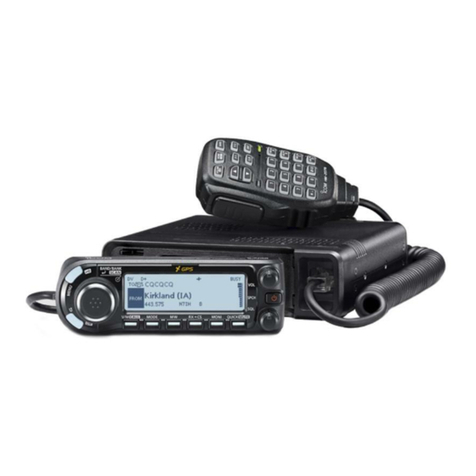
Icom
Icom D-STAR ID-4100A Setup guide
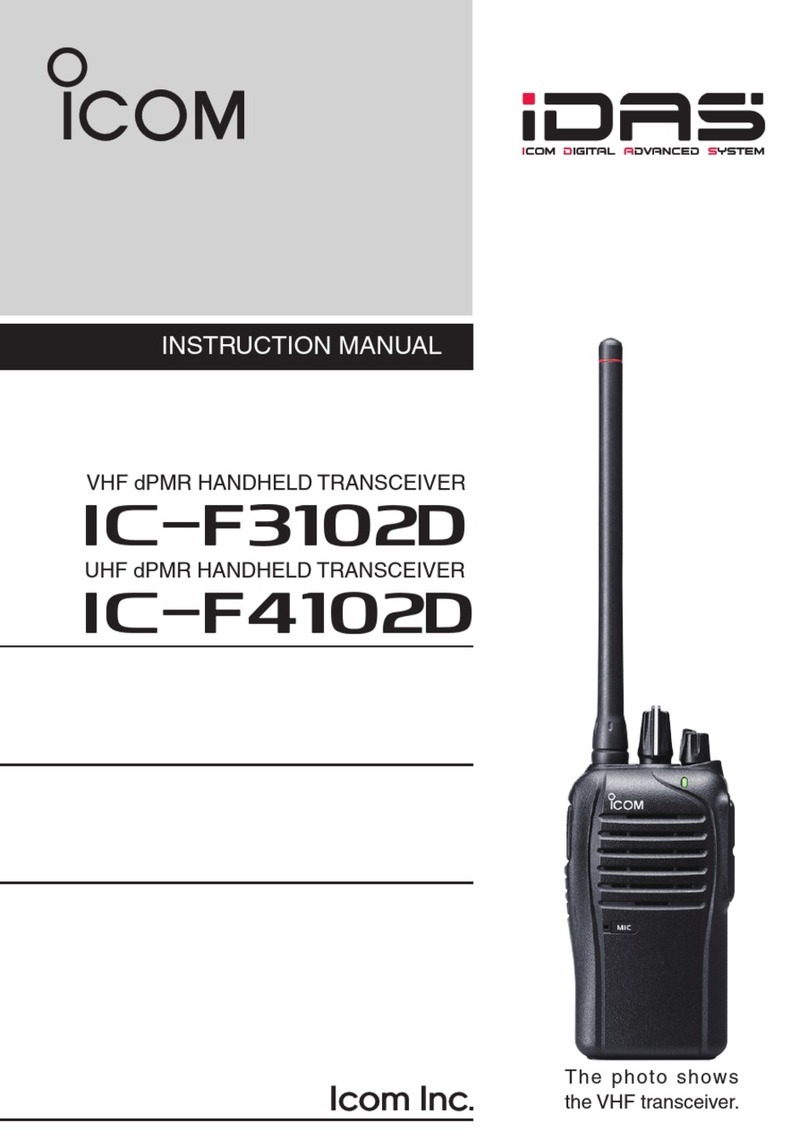
Icom
Icom iDAS IC-F3102D User manual
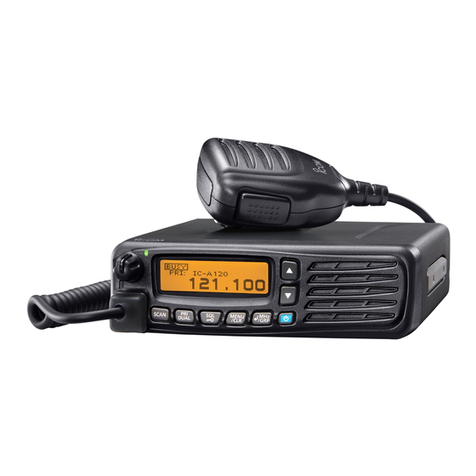
Icom
Icom IC-A120 Installation guide
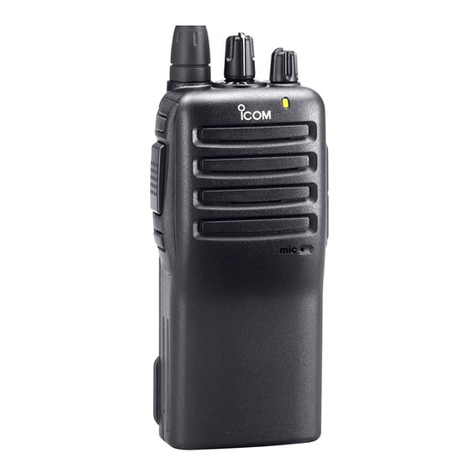
Icom
Icom IC-F14 User manual
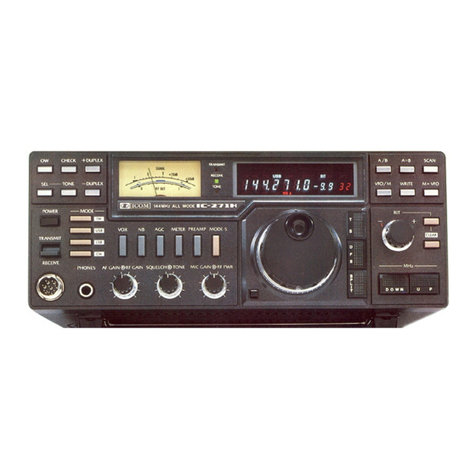
Icom
Icom IC-271A User manual
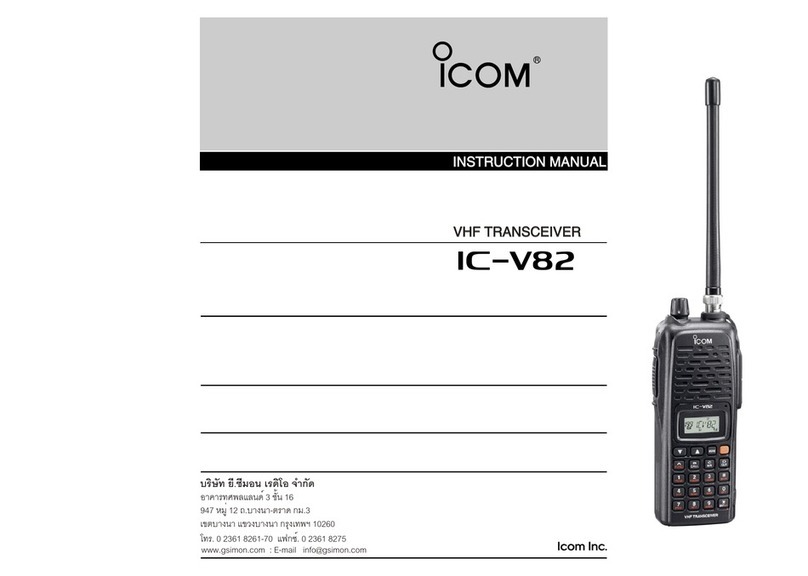
Icom
Icom IC-V82 User manual
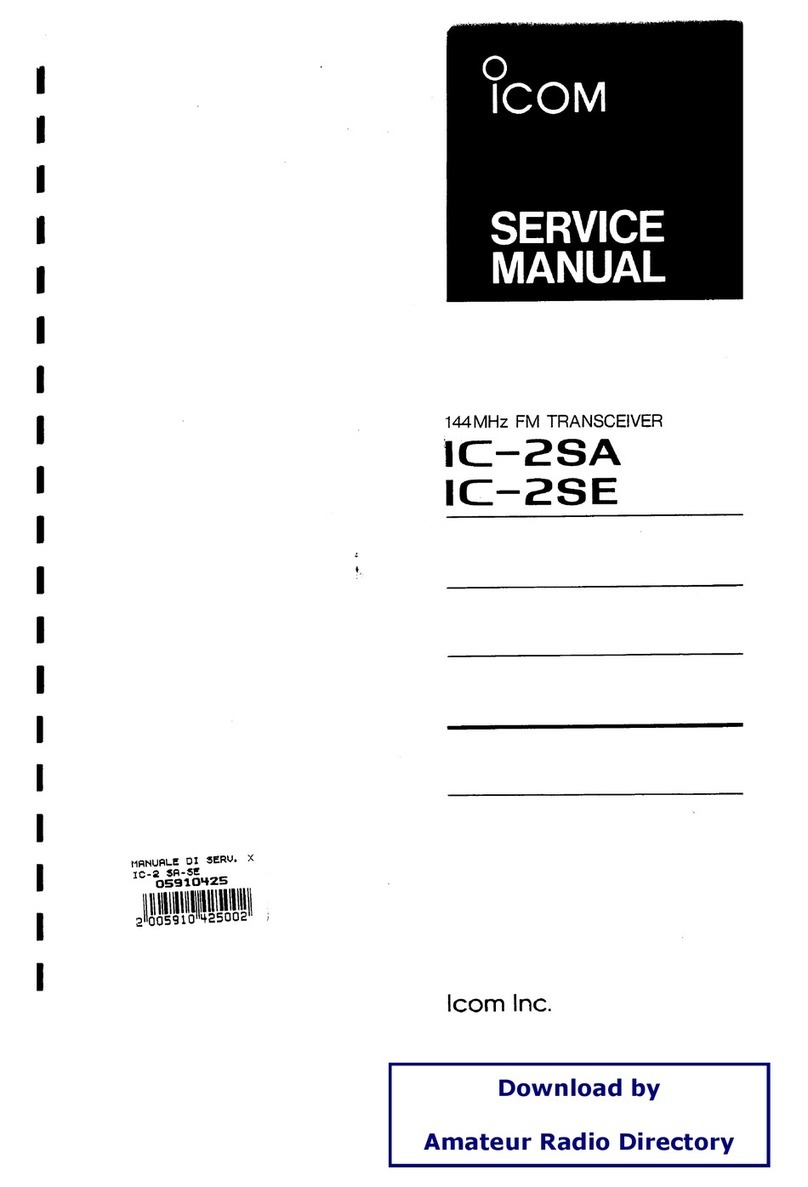
Icom
Icom IC-2SA User manual
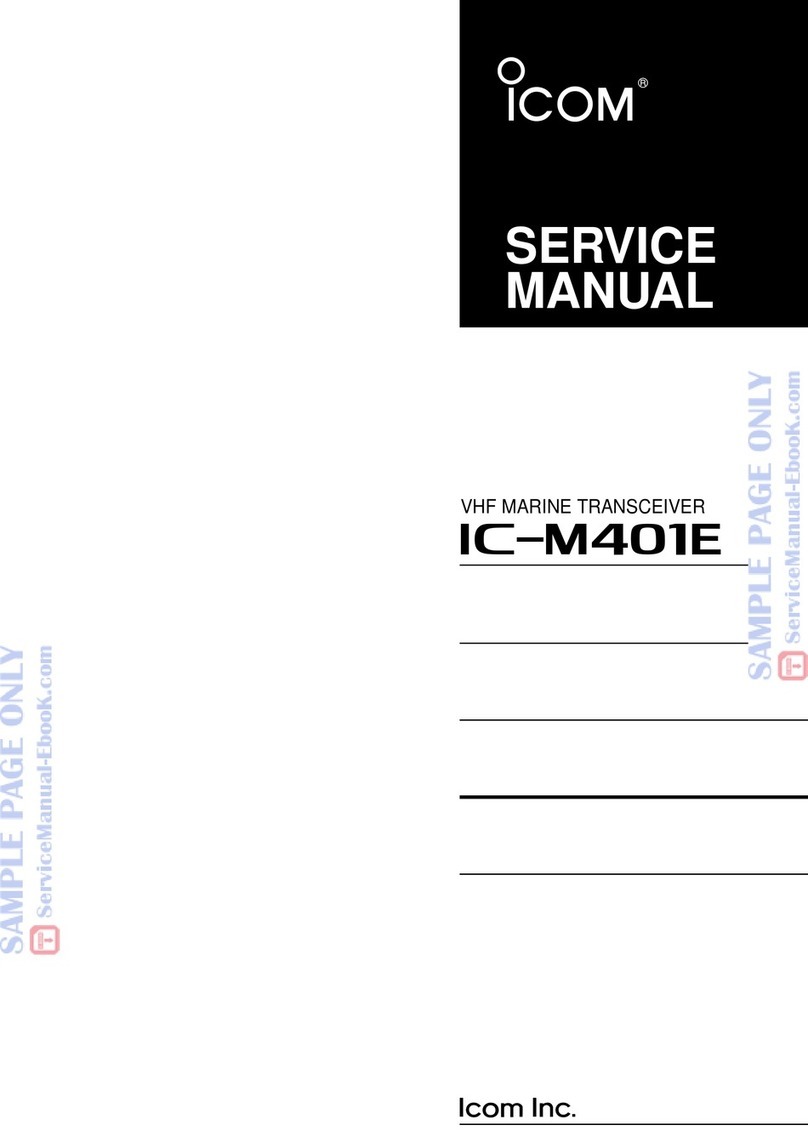
Icom
Icom IC-M401E User manual
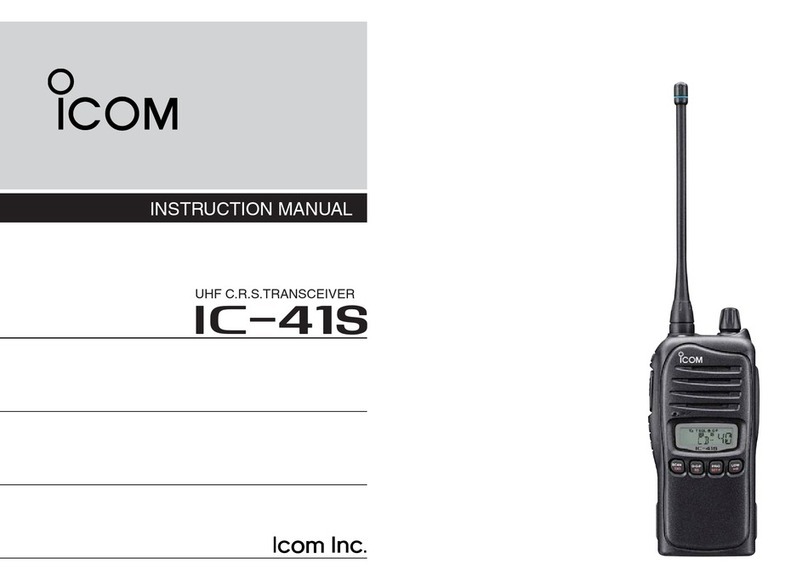
Icom
Icom IC-41S User manual
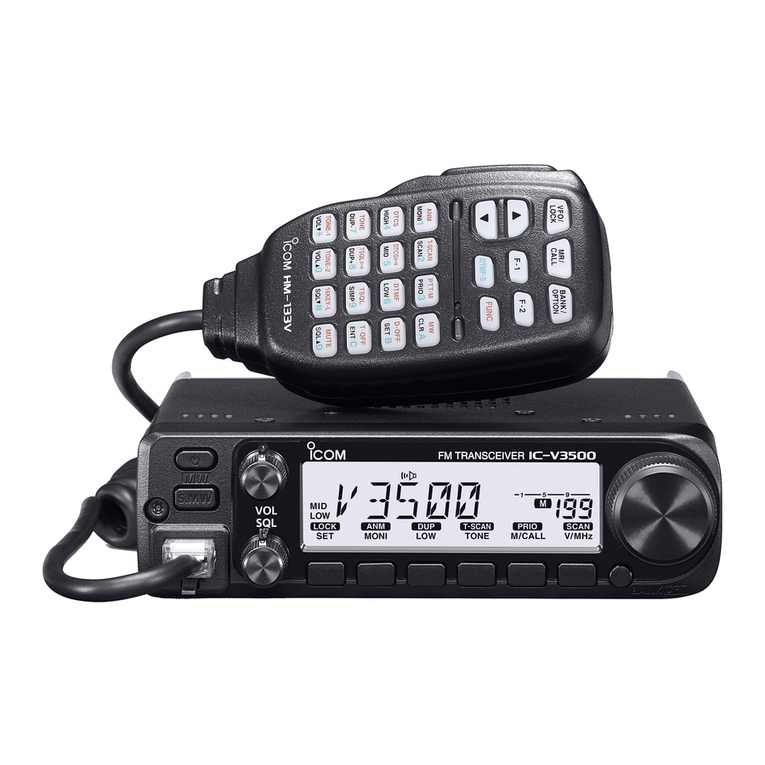
Icom
Icom IC-V3500 User manual
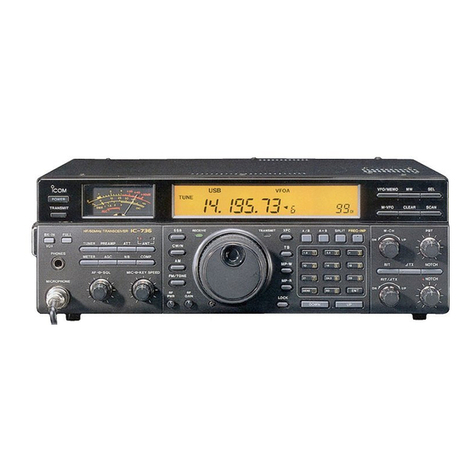
Icom
Icom IC-738 User manual

Icom
Icom IC-M73 User manual
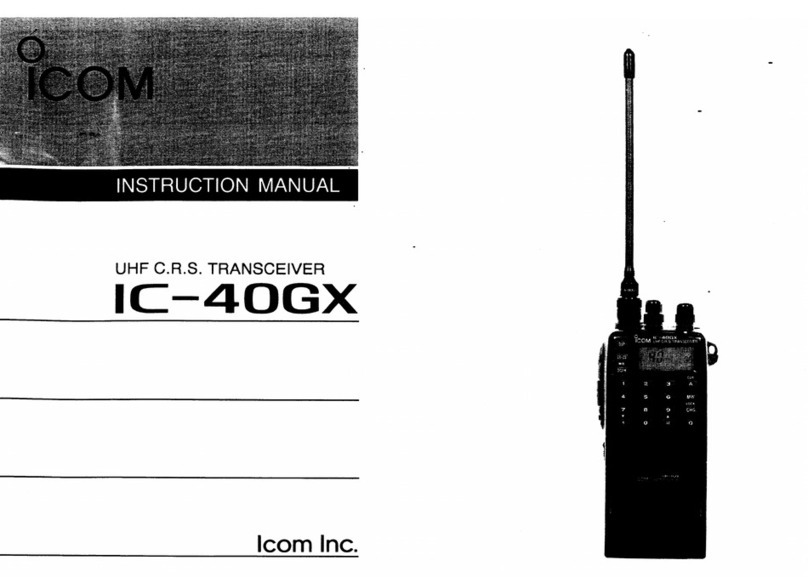
Icom
Icom IC-40GX User manual
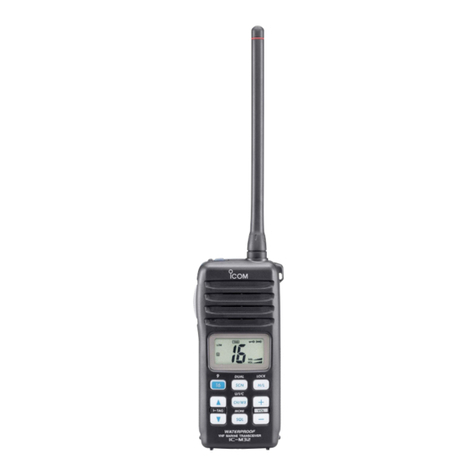
Icom
Icom IC-M32 User manual
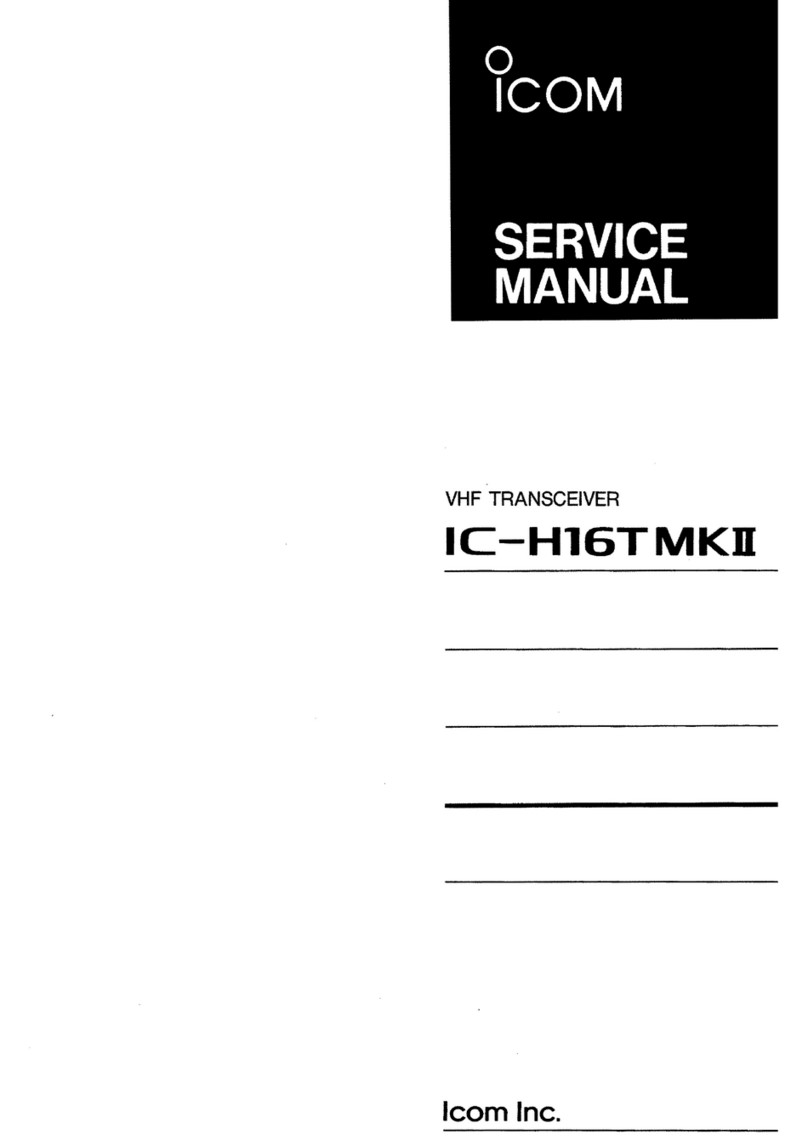
Icom
Icom IC-H16T MKII User manual
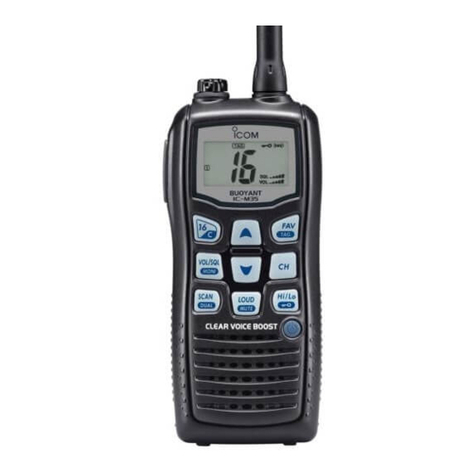
Icom
Icom IC-M35 User manual
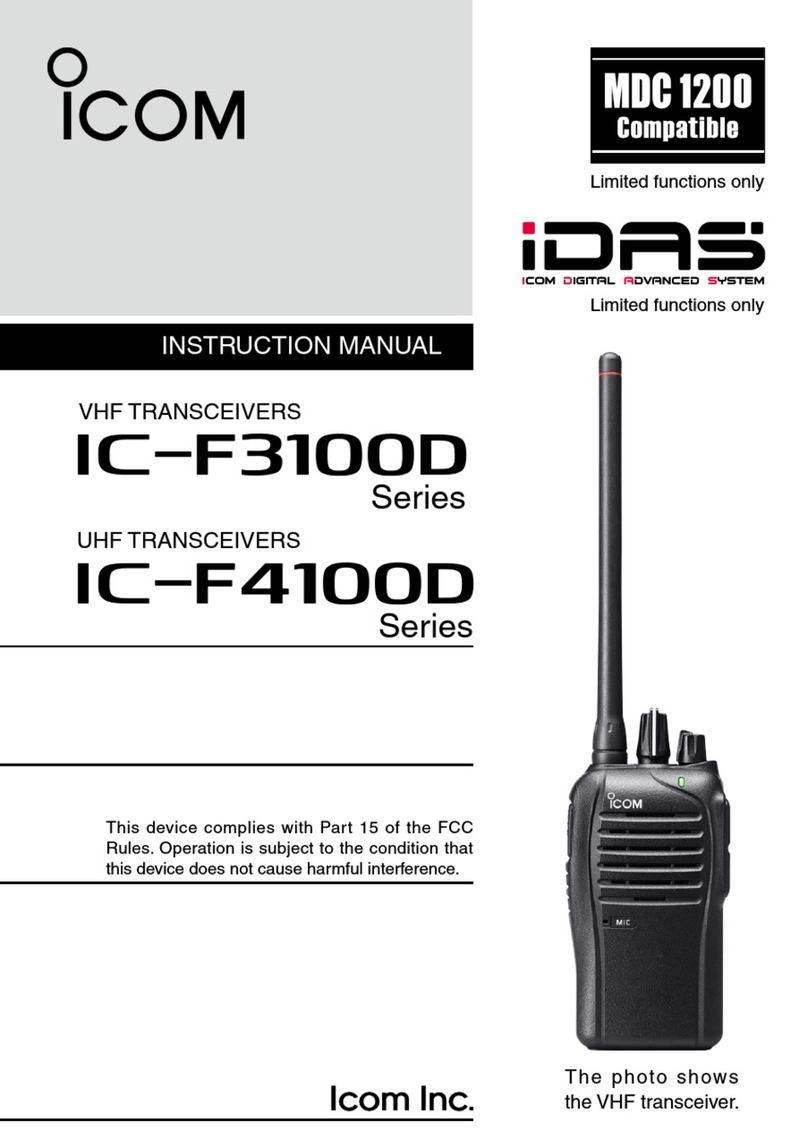
Icom
Icom IC-F3100D series User manual
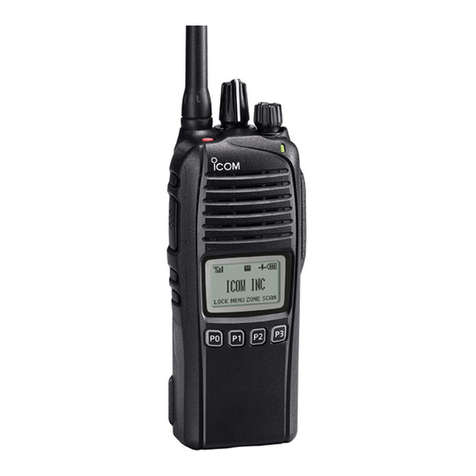
Icom
Icom IC-F3360D Series User manual
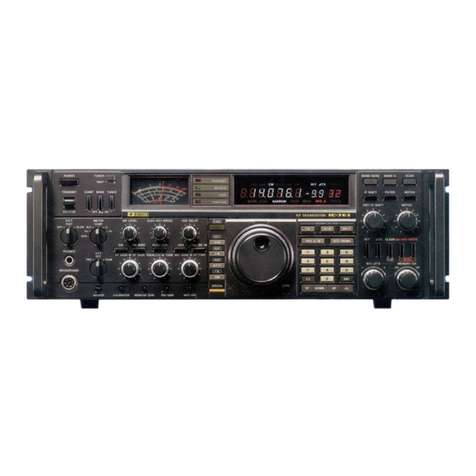
Icom
Icom IC-761 User manual

Icom
Icom IC-F3262DT User manual
